The Patent Office
Reprinted from "Crown Jewels of the Wire", May 1989, page 17
THIRD RAIL INSULATOR
Patent No. 628,667 dated July 11, 1899
by Charles King
and George Mead
In the early 1970's, Carol and John McDougald found two unusual insulators at
a flea market. The owner said that both were found in the same pole hole where
someone had pitched them. One looked like a third rail insulator and the other
was a very crude three piece cable-top. Both were made of the same type of
stoneware (not porcelain) with a transparent, shiny glaze. We will show the
cable-top insulator in this article since it was found with the third rail
insulator and is made of similar material.
The cable-top unit is pictured below and at the top of the next page. You can
see that it is very crude and made up of three nested shells fused together.
There are still traces of cement on the bottom of the insulator where it may
have been cemented on the underground vertical walls of the tunnel under the
rail. This insulator was probably used to carry the electric feeder cable.
Notice the large damaged area on the outside skirt which was made before being
glazed and fired. The whole body seems to sag as if the clay had been much too
wet when it was made, leaving no good means of securing the tie-wire to the
crown. This must have been the cheapest insulator available.
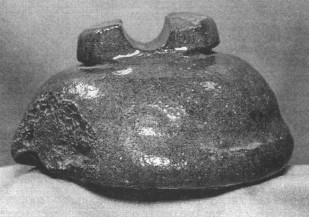
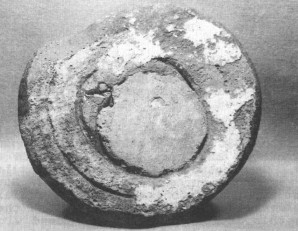
The third rail insulator pictured below is made of similar stoneware and
glaze, but the construction is of much better quality. There is a horizontal
groove around the top with a vertical groove on opposite sides of the top which
intersects the horizontal groove. This horizontal groove is not a tie wire groove as can be seen in the patent description (see end of
this article).
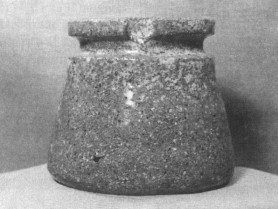
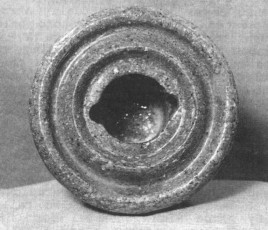
The metal cap held the electric rail and had two lugs which fit
into the vertical and horizontal grooves. By turning the metal cap 90 degrees
(where the cap lugs would be halfway between each vertical groove), it could be
snugly locked in place on top of the insulator. The pinhole of the third rail
insulator is threadless with two opposite vertical grooves which intersects a
horizontal groove near the top of the pin hole. A pin with a horizontal lug was
used to lock the insulator in place. The patent describes these features in
detail, so I am sure that this insulator was made with the patent claims.
Both insulators are unmarked. The manufacturer of the cable-top insulator is
still a mystery, but I believe that the third rail insulator was sold by Ohio
Brass. What, you say, was a porcelain company doing making insulators of
pottery? Well, the answer to that question is open to speculation, but I would
guess that the answer may be found in the strength needed for that severe
service and the close association Ohio Brass had with Akron High potential.
Third rail insulators take a lot of abuse from vibration as the train passes
over the rails. The job of the insulator was, of course, to insulate the
electric rail, but, in so doing, it had to be very strong to hold the steel rail
in place.
Ohio Brass was associated with Akron High potential, possibly from the very
beginning of Akron when they were formed about 1900 (recall the patent date is
1699). Akron initially manufactured general ceramic products (!) and entered the manufacture
of wet process porcelain pin type insulators sometime between 1903 and 1905 (info
from Jack Tod's new book, Porcelain Insulators Guide Book).
In the Ohio
Brass catalog (actually Akron's production of pin types) dated 1907 (see the
photo below), this same third rail insulator was shown as "Type A - Form
1". The catalog described the insulator as being made of "Semi-
Porcelain" and being "highly glazed"; and the catalog noted that
the insulator was "patented". The Ohio Brass catalog dated 1914 shows
this same insulator, but describes it as a "Porcelain block" -- it was
now made of porcelain.
Possibly by 1914, Ohio Brass (having purchased the Akron plant in 1910) was
able to manufacture the third rail insulator using a stronger form of porcelain
than was available earlier. It is conceivable that Akron was not able to produce
strong porcelain during the those early years and used instead their
"general ceramic" technology. Consequently, I believe that this third
rail insulator was manufactured by Akron High Potential for Ohio Brass circa
1900 to 1910. I have seen one other identical third rail insulator in Jerry
Turner's collection. No other cable-top insulators, as described earlier, are
known to me, and this one may remain a mystery.
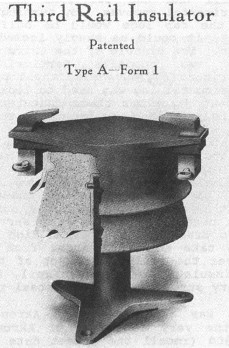
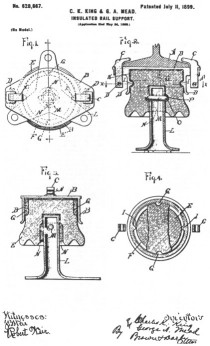
Medium Image (79 Kb)
Large Image (145 Kb)
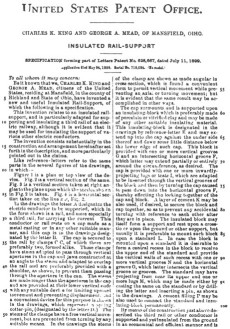
Medium Image (157 Kb)
Large Image (381 Kb)
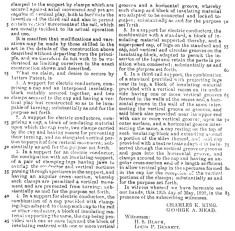
Medium Image (113 Kb)
Large Image (270 Kb)
| 